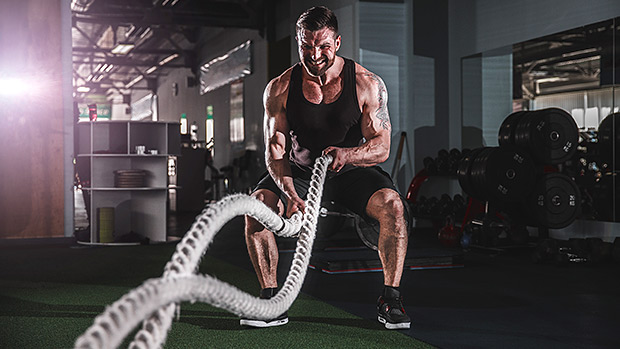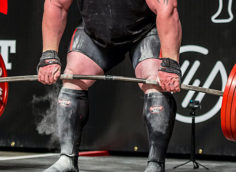Metabolic Finishers: Do's and Don'ts
Want to boost fat loss, build work capacity, and improve health? Just cap off a few of your weekly workouts with a metabolic finisher.
But not so fast. Finishers are tricky. Push too hard and you'll burn out. Take it too easy and you'll miss out on the benefits. Pick the wrong exercises and you'll end up hurt.
So follow these five guidelines:
1 – Choose exercises wisely.
Do: Pick low-risk exercises.
Choose movements that are hard to mess up: exercises that make it easy to maintain good form when you're fatigued.
Avoid anything potentially catastrophic, like bashing your foot with a sledgehammer. Some good options are sled sprints, stationary bike sprints, medicine ball throws and slams, battle ropes, loaded carries like farmer's walks, and complexes.
Don't: Use technical exercises or heavy loads.
You can put high-impact plyos in this category, too. And while they all have their place, they're not the best choice for finishers.
Pairing fatigue with high-impact plyos is a joint beatdown waiting to happen. Once fatigue sets in and you start losing your form, things like box jumps are guaranteed to wreak havoc on your knees, hips, and low back. You can still train anaerobic power in a fatigued state with more joint-friendly alternatives like sled sprints, hill sprints, or medicine ball throws/slams.
There are plenty of alternatives to technical exercises that can jack up your heart rate without jacking up your joints. Instead of doing AMRAP barbell snatches and shredding your shoulders like coleslaw, do one-arm dumbbell snatches.
Instead of barbell thrusters, try landmine thrusters.
Instead of cleans, opt for kettlebell swings.
Using heavy loads as part of a finisher can drive you into a recovery hole. Finishers aren't the time to go for a PR. Save that for your actual training.
2 – Keep it short and intense.
Do: Limit the duration to 8-12 minutes.
A "finisher" that lasts longer than 8-12 minutes isn't a finisher; it's an additional workout. Focus on intensity, not duration.
Don't: Fall for the "more is better" mindset.
If your finishers generally last longer than 8-12 minutes, or you feel the need to do another one, you're either not pushing yourself hard enough or you're flying high on cortisol.
If you fall into the latter group, take your foot off the gas. Ease up on the length of your finishers. Why? Because you're wasting valuable training time. The more you add into a training program, the more you have to take out.
Spending more time on conditioning means less time can be allotted to building strength. While HIIT finishers can provide some unique benefits, they're merely icing on the cake and should be treated as such.
Another reason? Your cortisol levels will shoot through the roof. Cortisol can be useful in the short term while training, but a laundry list of problems can arise when it's elevated for too long.
Since strength training already spurs a big cortisol release, tacking on long bouts of HIIT can be detrimental. An inability to control cortisol after training can increase catabolism, slow muscle tissue repair, negatively affect your hormones, and inhibit fat loss.
While the notion that conditioning "kills your gains" is outdated, long-duration finishers can decrease the body's anabolic response to lifting. The process is complex so you'll want to check out The Best Damn Cardio for Natural Lifters. But the main idea is that excess cortisol paired with increased AMPK can inhibit mTOR activation after a workout, which can subsequently inhibit muscle growth.
3 – Remember, HIIT stands for high-intensity, not medium-intensity.
Do: Make it hard.
Your chosen exercises need to be able to jack up your heart rate in 15-30 seconds. Compared to medium-intensity intervals, high-intensity intervals produce a powerful EPOC effect, which facilitates the burning of more calories after training.
Don't: Waste gym time with something you can do separately.
Stop calling your 7-mph jog on the treadmill "high-intensity" just because you're out of breath.
While sub-maximal cardio/conditioning has its place, it generally requires more time to be effective, and it can be done outside of the gym or in another workout. If your so-called HIIT finisher is nothing more than a glorified Zumba class, you should do one of two things:
- Skip it altogether and extend your lifting session instead. If you can't ramp up the intensity of your finishers, you're better off using that 8-12 minutes to accumulate more volume, hit a lagging body part, or tack on some accessory exercises.
- Crank up the intensity. If your goal is fat loss and you want to make HIIT a priority, get intentional about upping the intensity. The goal should be to jack up your heart rate relatively quickly to produce an EPOC (excess post-exercise oxygen consumption) effect and yield HIIT's hormonal benefits. Don't turn it into a sub-maximal cardio session.
4 – Rest as needed (but not too much).
Do: Find a rest/recovery sweet spot.
Since the most important component of HIIT is intensity, recovery between sets is a must. We now know that HIIT dispersed throughout the day might be just as effective as doing it all at once, which suggests that the quality of the work being done is more important than the rest (or lack thereof) between sets.
A good rule of thumb is to shoot for 4-8 sets of 30-60 seconds with a couple minutes rest between rounds.
Don't: Take rest or recovery to the extreme.
For lifters with health and physique goals, pre-determined rest periods aren't all they're cracked up to be during HIIT finishers. Some will find that their heart rate can recover fairly quickly after a hard interval; others might need an oxygen mask for a solid two to three minutes before they can move on.
Prescribing pre-determined rest periods at the expense of all else may hinder your ability to push as hard as possible on each set. That said, you don't want to take too long in between bouts, either. Resting upwards of two minutes between sets may wind up taking 20 minutes. That's not a finisher, it's a workout. Ain't nobody got time for that.
5 – Switch it up.
Do: Keep it fun (and effective).
Constantly switching between various forms of HIIT is a good idea. Avoiding adaptation is especially good for fat loss, and switching things up regularly will make finishers less monotonous and more fun.
Don't: Do the same thing over and over again.
Sticking with the same modality will decrease benefits. Inefficiency, in this case, is a good thing. Keep switching up the exercises or tools you're using to avoid adaptation... and drudgery.





